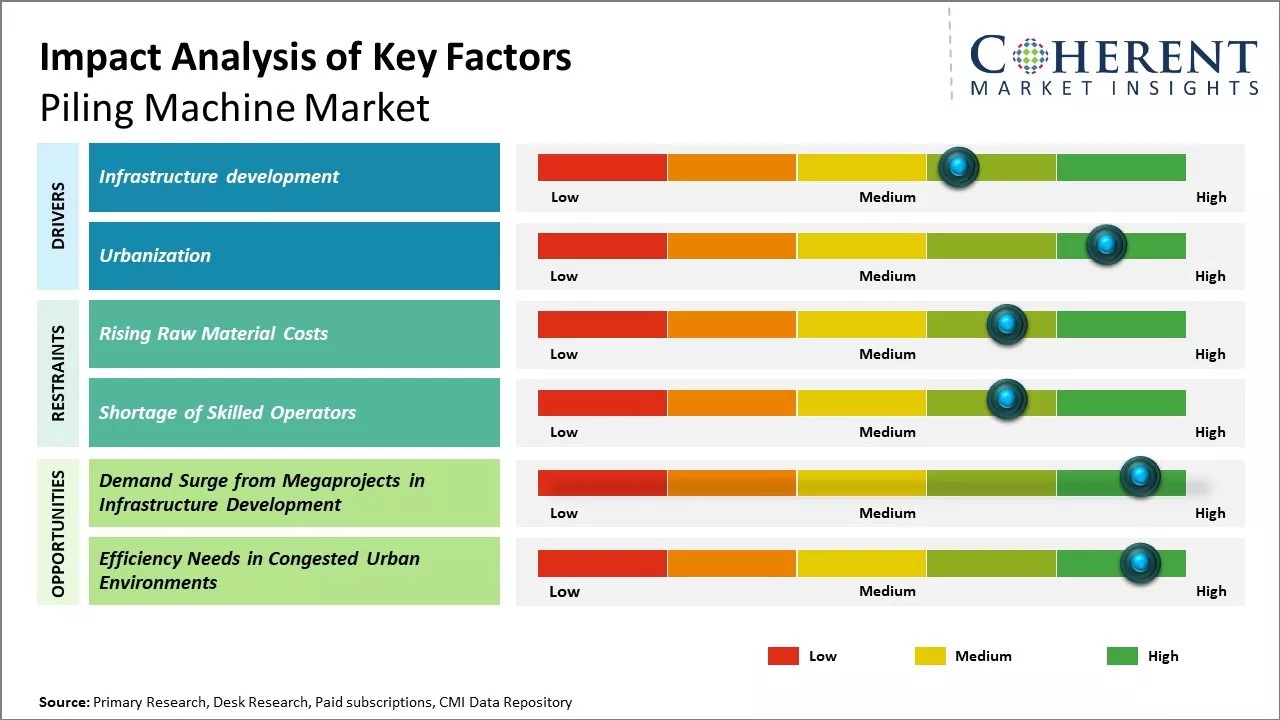
Piling machine market is estimated to be valued at USD 5,705.8 Mn in 2025 and is expected to reach USD 8,874.7 Mn by 2032, exhibiting a compound annual growth rate (CAGR) of 6.2% from 2025 to 2032.

To learn more about this report, Download Free Sample
The piling machine market demand is growing rapidly, driven by the rising construction activity across commercial and residential sectors. Urbanization and infrastructure development in emerging regions like Asia and Latin America are major growth drivers. Countries such as India, Indonesia, and Brazil are investing heavily in transportation and public infrastructure, boosting demand for advanced piling equipment. Government-backed projects like India’s PM Gati Shakti and Indonesia’s National Strategic Projects are creating significant opportunities. Additionally, the shift toward eco-friendly, low-noise machines is encouraging innovation in the market. These trends position the piling machine market for strong growth in the near future.
|
Current Event |
Description and its Impact |
|
Global Construction Rebound and Regional Divergence |
|
|
Technological Disruption in Automation |
|
Uncover macros and micros vetted on 75+ parameters: Get instant access to report
In terms of operating mode, Diesel segment is estimated to account for the largest market share of 63.7% in 2025 due to its high-power output, reliability in heavy-duty applications, and widespread availability across construction and infrastructure projects. Diesel-powered piling machines are preferred for large-scale operations, particularly in remote or undeveloped areas where electric infrastructure may be limited.
For instance, in May 2025, Comacchio has introduced the new CH 850, its sixth piling rig in its CH line as well as the largest machine in the lineup.
Driving and impact driven piling is projected to hold largest share in the global market during the forecast period. This is owing to its wide applicability in large-scale foundation projects, including bridges, highways, high-rise buildings, and marine structures. The method’s ability to deliver high load-bearing capacity, faster installation times, and suitability for various soil conditions makes it a preferred choice for contractors and infrastructure developers.
Additionally, ongoing urban development and infrastructure modernization initiatives are further boosting demand for driving and impact piling solutions.
For instance, in January 2025, Junttan, a global leader in pile‑driving machinery, launched its Evolution Series, debuting with the high‑performance DR5 drilling rig. This major investment brings a ground‑breaking design optimized for Full Displacement and Continuous Flight Auger applications.
In terms of end use industry, the residential construction is projected to lead the market in 2025. Growth is attributed by to the rising demand for housing due to increasing urban populations, rapid urbanization in emerging economies, and supportive government initiatives for affordable housing.
Additionally, ongoing real estate development, smart city projects, and improved access to financing are further fueling the expansion of residential construction activities globally.
For instance, Roger Bullivant Limited (RBL) unveiled three revolutionary 3500 Series Driven Piling Rigs: the 3501, 3502, and 3503. This ground-breaking triple launch underscores RBL’s unwavering commitment to pushing the boundaries of design and functionality.

To learn more about this report, Download Free Sample
North America has established itself as the dominant region with estimated market share of 33.9% in 2025. The region accounts for the largest share owing to strong presence of key industry players as well as a highly developed infrastructure sector. The transportation and construction industries have also driven massive infrastructure projects involving new highways, bridges and buildings.
Between April 2024 and March 2025, the Ontario government allocated approximately USD 3.9 billion toward the repair and expansion of highways and bridges across the province. This has generated substantial demand for piling machines in the region to support excavating and foundation works.
North American manufacturers are responding with heavy investment in advanced piling solutions, including GPS-guided and hydraulic rigs that support equipment rental fleets capable of cross-border deployment throughout the U.S. and Canada.
Furthermore, presence of advanced rental fleets ensures accessibility of equipment on both small and large-scale jobsites. Regional rental companies also facilitate equipment exchange across borders by playing the role of an intermediary. This mature rental infrastructure access to high-performance machinery for both urban and remote projects is boosting the piling machine market revenue.
Asia Pacific region is expected to exhibit the fastest growth in the market contributing an estimated CAGR of 7.4% in 2025. Several developing nations in the region such as India and China are experiencing tremendous urbanization, which is rapidly expanding their infrastructure needs. This offers lucrative opportunities for piling solution providers to penetrate emerging markets.
In India, for example, Sany India’s advanced rigs completed 2,523 piles for the Bengaluru Metro expansion in April 2025, showcasing the technical capabilities driving regional market penetration. Local players as well as international names are aggressively marketing their products and services.
Apart from this, Asian governments are heavily investing in road connectivity and building new smart cities. This boosts demand for piling machines required for various ground improvement techniques and transport infrastructure projects. Export potential exists from ASEAN nations to serve requirements in African and Middle Eastern countries.
The U.S. market is poised to hold around 19.7% shares in 2025. Growth is driven by the Infrastructure Investment and Jobs Act which has significantly bolstered demand for piling machine market through major bridge, subway, and airport projects.
For instance, the Act allocated nearly USD 635 million in FY 2024 to support 22 bridge repair and replacement projects nationwide, including upgrades to the I‑270 bridge over the Mississippi and the Western Hills Viaduct in Cincinnati. This massive federal infusion is a part of a broader USD 40 billion bridge initiative which is fueling extensive foundation work that requires heavy-duty piling rigs.
Similarly, the “Bridge Formula Program,” backed by USD 26.5 billion for around 15,000 bridges, is deploying deep-foundation equipment to rehabilitate aging infrastructure. Meanwhile, subway expansions and airport terminal modernizations funded through IIJA are also increasing demand for specialized piling machines capable of operating in urban and constrained environments. These combined efforts are supporting the piling machine market share.
For instance, in February 2023, Eimco Elecon unveils fuel-efficient piling rigs for the infrastructure in the U.S.
China is projected to hold around 12.5% share in the global piling machine market revenue in 2025, owing to rapid urbanization, large-scale infrastructure development projects, and significant investments in transportation and energy sectors. The government's continued focus on expanding high-speed rail networks, highways, and smart city initiatives is driving demand for advanced piling equipment.
For instance, in February 2025, The Erhang Changqing pile-driving vessel, which features the world's tallest derrick at the stern with the highest pile-driving capacity, set sail from Nantong in East China's Jiangsu Province to the construction site of the Hangzhou Bay Bridge in East China's Zhejiang Province.
| Report Coverage | Details | ||
|---|---|---|---|
| Base Year: | 2024 | Market Size in 2025: | USD 5,705.8 Mn |
| Historical Data for: | 2020 To 2024 | Forecast Period: | 2025 To 2032 |
| Forecast Period 2025 to 2032 CAGR: | 6.2% | 2032 Value Projection: | USD 8,874.7 Mn |
| Geographies covered: |
|
||
| Segments covered: |
|
||
| Companies covered: |
Dieseko Group, IQIP, MKT Manufacturing Inc., Soilmec S.p.A., Bauer Group, BSP TEX, Changsha Tainwei Engineering Machinery Manufacturing Co., Ltd., International Construction Equipment, Junttan Oy, Liebherr, SANY Group, XCMG Group, Tescar, Casagrande S.p.a., Fundex Equipment |
||
| Growth Drivers: |
|
||
| Restraints & Challenges: |
|
||
Uncover macros and micros vetted on 75+ parameters: Get instant access to report
The rapid pace of infrastructure development activities all around the world has emerged as a key driver propelling the global piling machine market growth. Governments across both developed and developing regions are also constructing dams, harbors, ports and other mega infrastructure projects at an unprecedented scale.
For instance, Italian manufacturer Casagrande recently supplied six B 250 hydraulic piling rigs for large-scale projects like the LNG plant in Cochin, the Krishnapatnam Port expansion, and industrial sites in Hazira and Assam—showcasing growing adoption of deep foundation technologies across India. Since piling works form an integral part of the foundation for any large infrastructure construction, it boosts piling machine market demand.
Rapid urbanization worldwide is also expected to drive the piling machine market growth. With more people migrating to cities in search of employment and better standards of living, urban centers across developing nations are expanding at a rapid pace. This has dramatically increased the construction of residential and commercial smart buildings including high-rises.
Reliable foundation support is paramount for the safety and longevity of tall structures, which spurs the use of piling installations. Swelling urban populations boosts the development of mass transit systems and roads within cities. Mega projects such as metros, flyovers and underpasses also create large-scale demand for sophisticated foundation laying equipment.
Demand Surge from Megaprojects in Infrastructure Development is playing a pivotal role in accelerating the growth of the piling machine market, as deep foundation work is a critical component of nearly all large-scale civil engineering projects. From cross-border highways to metro rail expansions and smart city construction, governments around the world are executing multibillion-dollar infrastructure initiatives that require high-performance piling equipment to ensure structural integrity.
For instance, the Neom City project in Saudi Arabia, one of the world’s largest ongoing megaprojects, has created enormous demand for rotary and impact piling rigs used in the construction of foundations for skyscrapers, tunnels, and transport hubs. Similarly, India’s Bharatmala and Delhi–Meerut RRTS projects have actively employed piling machines in large numbers to complete viaducts and station foundations at speed and scale.
*Definition: The piling machine market involves equipment used to install foundations and retaining walls for structures. Piling machines can handle a variety of pile types including precast concrete, driven H-piles, pipe piles, and more. These serve construction projects like buildings, bridges, marine structures, and retaining walls. Piling machines utilize techniques such as impact driving, vibrating, drilling, and others to drive or screw piles deep into the ground to form strong and stable foundations that can support large structural loads. These are essential for infrastructure projects.
Share
Share
About Author
Ramprasad Bhute is a Senior Research Consultant with over 6 years of experience in market research and business consulting. He manages consulting and market research projects centered on go-to-market strategy, opportunity analysis, competitive landscape, and market size estimation and forecasting. He also advises clients on identifying and targeting absolute opportunities to penetrate untapped markets.
Missing comfort of reading report in your local language? Find your preferred language :
Transform your Strategy with Exclusive Trending Reports :
Frequently Asked Questions
Joining thousands of companies around the world committed to making the Excellent Business Solutions.
View All Our Clients